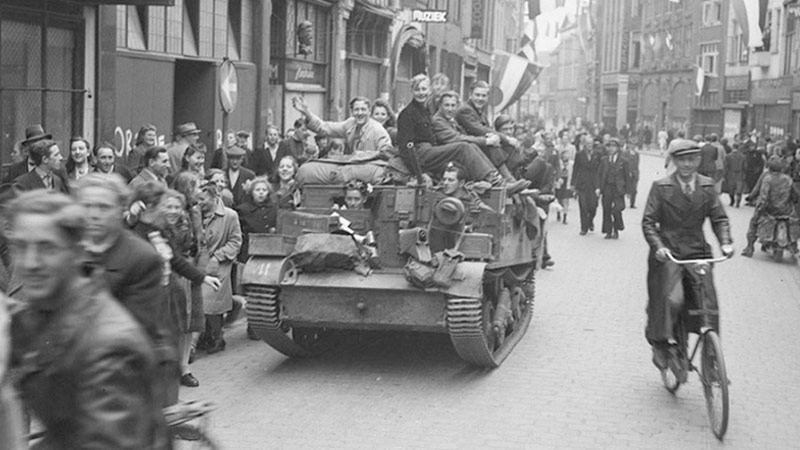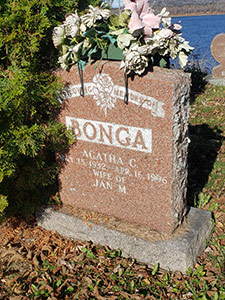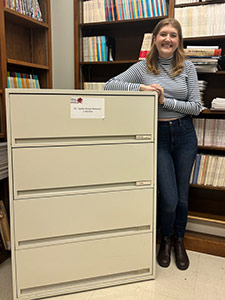Uncovering missing pieces of the Canadian liberation of the Netherlands
Author: Tim Jaques
Posted on Nov 8, 2024
Category: UNB Fredericton , Research

The story of Canada's role in liberating the Netherlands near the end of the Second World War has usually been told through the lens of high-ranking, educated officers. Thanks to the work of one University of New Brunswick (UNB) student, the voices of rank-and-file soldiers are being heard.
Mackenzie Smith (BA'22, MA’24) spent two years immersed in a trove of first-hand accounts from Canadian veterans who participated in the 1945 campaign, making it the basis of her master’s dissertation.
Smith was working as a research assistant at the Gregg Centre for the Study of War and Society and was tasked with doing an inventory of over 1,000 questionnaires completed in the mid-1990s.
“I was looking through and thought, ‘Wow, there’s so much interesting information here,’” said Smith, who had earlier honed her skills at the Gregg Centre by going through the personnel records of over 1,500 Canadians killed in action in Italy.
The collection was assembled by the late Dr. Agatha Bonga (C-FR'82, BA'96), who was born in Groningen, Netherlands in 1932 and lived in Rotterdam and other places in the Netherlands during the German occupation. She was living in Apeldoorn when I Canadian Corps liberated the town.
After the war, Bonga’s family immigrated to Canada, where she became a physician in Fredericton. She was an active member of the York-Sunbury Historical Society, and after her retirement, studied history at UNB.
Bonga sent the questionnaires to veterans near the 50th anniversary of the liberation of the Netherlands, intending to use the responses as the basis of her master’s dissertation research, but unexpectedly died in 1996.

Her family donated the completed questionnaires to UNB, where they formed the Dr. Agatha Bonga Memorial Collection at the Gregg Centre.
“It is a very in-depth collection that nobody touched after her passing. Every student who investigated the files afterward had switched their project or career path,” Smith said.
The questionnaires are in five sections over four pages. They address pre-war life, general service information, service in the liberation of the Netherlands, return to civilian life and whether the veteran had ever returned to the Netherlands after the war had ended.
“One thing that surprised me was how much qualitative information was contained there and how much some of the veterans wrote,” said Smith.
While some answers were brief and terse, some veterans included photos and newspaper articles. One veteran wrote 12 pages in response to the questionnaire.
Smith said Bonga had planned to anonymize and compress the responses and do a statistical analysis.
“While I did, in some cases, take a statistical route, my goal with this was to let those veterans’ voices speak and highlight what their experience was.”
The collection includes a wide range of veterans who served in many different ranks. Some higher-level officers speak to their experiences, but there are also privates and corporals that are not normally heard from.
"I was expecting this to be very statistical, very easily quantifiable data," said Smith. "But the veterans proved me wrong. There was so much nuance and detail in their responses. It was like they were transported back in time."
Smith based her master’s dissertation on a selection of 336 questionnaires from veterans of I Canadian Corps. Other questionnaires came from veterans of II Canadian Corps, the Royal Canadian Air Force, the Royal Canadian Navy and various women’s units—the last of which, Smith said, is worthy of a study of its own.
She discovered a more complex narrative than the familiar tales of joyous reunions and happy Dutch civilians. While those moments were certainly recorded, veterans also recounted instances of tension, mistrust and even violence when the German forces were disarmed.
"One veteran spoke about having to protect the Germans waiting to be evacuated from the country from the Dutch who were seeking retaliatory violence against their occupiers," Smith said.
"It's important to recognize that not every interaction in this time period was a positive one."
The importance of lower-ranking officers and non-commissioned officers in maintaining morale was also revealed.
“Quite a few veterans spoke to how lower-level leadership was very significant. That is a relatively new insight. Although these responses were collected 30 years ago, there are still many ways they can contribute to historical research today,” Smith said.
Smith is using the collection as the basis for her doctoral work at Western University.

Dr. Lee Windsor (PhD'06), Smith's dissertation supervisor and a military historian at UNB, believes the collection represents a missing piece of the Canadian war story.
"Historical writing on the Second World War is more intensely focused on campaigns that happened up to the end of 1944," he said. "What little has been written about the last months of the war in 1945, dusts over it as a happy end to a much darker and difficult history."
Windsor and Smith said the archive also sheds light on the activities of the Canadians in Italy, since many of the soldiers had fought there prior to joining the liberation of the Netherlands. Many recounted their Italian battle experiences, where fighting was fiercer.
“The Dutch liberation was a small and less horrific event for many of the veterans compared to the urban fighting in Ortona, or the bloody struggles for the Hitler Line south of Rome and along on the Gothic Line in northern Italy,” said Windsor.
The veterans' accounts, Windsor said, reveal the complexity of that final chapter—not just the battles, but the daunting task of rebuilding a shattered country and reintegrating soldiers into civilian life.
"These questionnaires capture that civilian-soldier interaction at the end of a long and excruciating experience. And it's not all rosy, as Mackenzie discovered in her research,” said Windsor.
For Smith, the project had personal significance.
As a woman working in the traditionally male-dominated field of military history, she sees it as a way to honour Dr. Bonga’s legacy.
"She was an older woman. She was going into military history in the 1990s—traditionally a male-dominated space. It means a lot that I'm able to continue her legacy,” said Smith.
Dr. Bonga’s candid recollections from the war are written in Dutch.
Photo 1: Dutch civilians on a WASP of 7th Reconnaissance Regiment (17th Duke of York's Royal Canadian Hussars), 3rd Canadian Infantry Division, celebrating the liberation of Zwolle, Netherlands (Donald I. Grant / Canada. Dept. of National Defence / Library and Archives Canada / PA-136176)
Photo 2:The grave of Dr. Agatha Bonga (C-FR'82, BA'96) at Fredericton Rural Cemetery Extension.
Photo 3: Mackenzie Smith (BA'22, MA’24) standing by the cabinets containing the Dr. Agatha Bonga Memorial Collection at the Gregg Centre for the Study of War and Society at UNB’s Fredericton campus.
